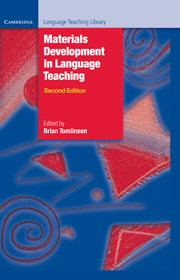Book contents
- Frontmatter
- Contents
- Preface
- Glossary of basic terms for materials development in language teaching
- Acknowledgements
- 1 Introduction: principles and procedures of materials development
- Part A Data collection and materials development
- 2 Using corpora in the language classroom
- 3 Concordances in the classroom without a computer: assembling and exploiting concordances of common words
- 4 Telling tails: grammar, the spoken language and materials development
- Comments on Part A
- Part B The process of materials writing
- 5 A framework for materials writing
- 6 Writing course materials for the world: a great compromise
- 7 How writers write: testimony from authors
- Comments on Part B
- Part C The process of materials evaluation
- 8 The analysis of language teaching materials: inside the Trojan Horse
- 9 Macro- and micro-evaluations of task-based teaching
- 10 What do teachers really want from coursebooks?
- 11 The process of evaluation: a publisher’s view
- Comments on Part C
- Part D The electronic delivery of materials
- 12 Developing language-learning materials with technology
- 13 New technologies to support language learning
- Comments on Part D
- Part E Ideas for materials development
- 14 Seeing what they mean: helping L2 readers to visualise
- 15 Squaring the circle – reconciling materials as constraint with materials as empowerment
- 16 Lozanov and the teaching text
- 17 Access-self materials
- Comments on Part E
- Conclusions
- Recommended reading
- Index
8 - The analysis of language teaching materials: inside the Trojan Horse
Published online by Cambridge University Press: 09 February 2023
- Frontmatter
- Contents
- Preface
- Glossary of basic terms for materials development in language teaching
- Acknowledgements
- 1 Introduction: principles and procedures of materials development
- Part A Data collection and materials development
- 2 Using corpora in the language classroom
- 3 Concordances in the classroom without a computer: assembling and exploiting concordances of common words
- 4 Telling tails: grammar, the spoken language and materials development
- Comments on Part A
- Part B The process of materials writing
- 5 A framework for materials writing
- 6 Writing course materials for the world: a great compromise
- 7 How writers write: testimony from authors
- Comments on Part B
- Part C The process of materials evaluation
- 8 The analysis of language teaching materials: inside the Trojan Horse
- 9 Macro- and micro-evaluations of task-based teaching
- 10 What do teachers really want from coursebooks?
- 11 The process of evaluation: a publisher’s view
- Comments on Part C
- Part D The electronic delivery of materials
- 12 Developing language-learning materials with technology
- 13 New technologies to support language learning
- Comments on Part D
- Part E Ideas for materials development
- 14 Seeing what they mean: helping L2 readers to visualise
- 15 Squaring the circle – reconciling materials as constraint with materials as empowerment
- 16 Lozanov and the teaching text
- 17 Access-self materials
- Comments on Part E
- Conclusions
- Recommended reading
- Index
Summary
Introduction
One of my earliest memories as a once untrained, unqualified language teacher is of the principal of my first school proudly presenting me with my coursebook. It was, she explained, the ‘best book available’, with the most up-to-date method, that would guarantee excellent results. It had, what’s more, a major technological innovation – a piece of green card which students should use to cover the text whilst they looked at four pictures and listened to the reel-to-reel tape recordings. She showed me how it worked. The recording would say ‘It is half past nine. Deborah is having breakfast and listening to some music on the radio. The maid is carrying a tray with some more coffee on it.’ Then, I was to direct the students’ attention to the prompts printed next to the pictures, ‘(a) What time? (b) What/Deborah? (c) What/maid?’, and ask them to complete questions. I was to continue like that for each of the pictures and recordings. Next, the students were to remove the card, read the texts aloud and answer more questions, before we moved on to some substitution exercises on the grammar point. Finally, there was an instalment of a story which ran through the entire book. I could make up my own questions for that, or make slashed question prompts for the students to ask each other across the classroom. The next unit would be the same, and all units after that would be the same, until, at Unit 12, the book ended. There was a teacher’s book available, the principal told me, but I wouldn’t need it, apparently.
She was right, of course – I didn’t need the teacher’s book. The book was so scripted and provided so little that it was not long before I discovered that I had to contribute a lot more if I and my students were to stay sane in the classroom. Through the process of personal involvement that this required, I actually became grateful to the book writer for allowing me such space to teach myself how to teach, whilst providing at least a backbone of something that was deemed ‘a course’, in contrast to the somewhat random nature of activities and texts with which I supplemented it.
- Type
- Chapter
- Information
- Materials Development in Language Teaching , pp. 179 - 211Publisher: Cambridge University PressPrint publication year: 2011
- 58
- Cited by



